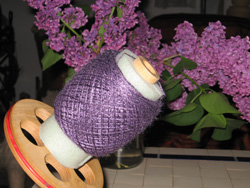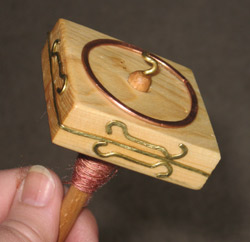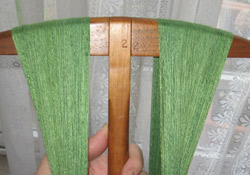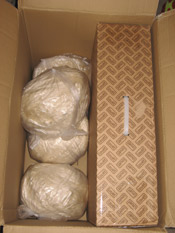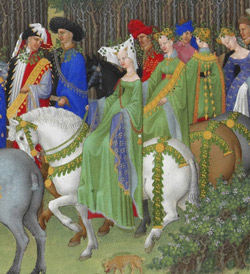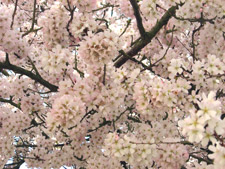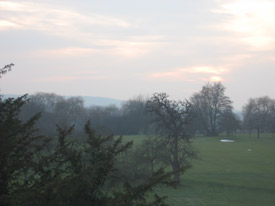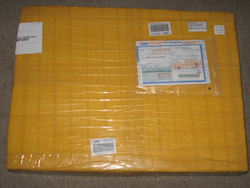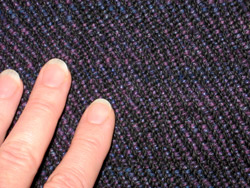The archives
Return to the
Now spinning
page
Explorations, Winter and Spring
January - May 2010
The lilacs have finally burst into bloom outside, and things have been just as colourful indoors -- which is a good thing, because (lilacs notwithstanding) the temperatures feel more like March than May.
The newest spinning obsession is silk in "Blackberry" (left). As fibre in a baggie, it looks like a plain, sombre colour; but after drafting and twisting, it gleams like a dark jewel. There are 400 yards of 2-ply yarn on that ballwinder, all of it deeply satisfying. This is actually spinning with a purpose -- unusual, as most of my spinning life is a joyful experiment looking for a destiny.
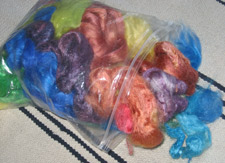
The colourful baggie (right) is the excuse, er, the impetus pushing me toward deep purple yarn. It's my "scrap" bag, the normal by-product of many dyebaths -- the recipient of roving ends that aren't fully dyed (the ends are often streaky), balls of dyed silk too small to sell, and colours that didn't quite "work" for some reason.
As scraps go, they're pretty darned nice. ;-) Normally they'd get used up in balancing spindles, or as a component in the occasional variegated yarn; but as you can see from the size of that overflowing gallon bag, they'd been piling up.
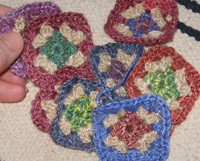
I love coincidences. On the very day I stood frowning at my silk scraps, a friend mentioned crochet... and a shimmering vision was born: a many-coloured silk stole -- crocheted! Except the occasional low-key edging, I hadn't crocheted anything for years, but that didn't matter. To refresh the skills, I made a few little granny squares...
...and darned if I don't like them, just as they are! They're small, as you can see in the picture -- but that's okay. It keeps them from looking like potholders. ;-)
The humble granny square has a tragic past (visions of bright afghans from the 1970s, in cheerful, ghastly acrylic yarns!). It's sad, but I myself contributed to the poor little structure's chunky legacy, back in the day.... The thought of making a fairly-elegant silk stole from tiny granny squares appealed enormously to my sense of Quirkiness. The catch: how could one tie this array of colours together in a way that would look elegant rather than kitschy?
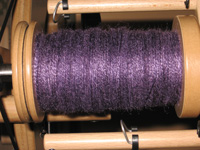
That's where the deep purple comes in. It goes with everything, and does it so well that even my not-so-favourite colours look nice in its company. I decided to spin enough to crochet borders around each square, to join them together, and to crochet a final border around the entire stole. (This initial 400 yards probably won't be enough. Good thing I like spinning this colour!)
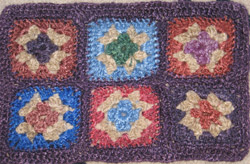
To test the Purple theory, I grabbed a few little squares, put borders on them, and crocheted them together as a test swatch. Fresh from the hook, the little sampler had me worried. It was a little too stiff, a little too puffy -- in short, it felt woolly. Gack.
Before abandoning hope, I decided to do as I'd do with the finished piece: wash it and lay it flat to dry. After all, nothing's really finished until it's been finished -- and I hear there's magic in the water. :-)
That thing about the magic -- it's true! The wet-finished sampler surpasses all hopes and aspirations. You can see how it looks in its photo, but the magical part is what you can't see: it's startlingly supple! Holding it in your hand is like holding a precious liquid. It drapes, shimmers, and flows. I want, I need to make something out of this stuff, something big enough to wrap up in. Whatever it will take to do that -- it's more than worth it.
I'm in love, all over again.
So there it is. The cat and I are spinning purple. And we're very happy. :-)
End notes, for inquiring minds
♦ The silk fibre shown is tussah, dyed in the colour "Blackberry". It is available for purchase, if you'd like to launch your own deep purple adventures (click here for more information).
♦ The ballwinder shown was made by Strauch Fiber Equipment Company (click here for their website).
♦ The wheel whose bobbin holds the yarn is the Louet Victoria (click here for Louet's European website).
One thing leads to another, then to another, then to another.
A need for a spindle of a certain weight led me to quickly make one, using materials from the scrap box. The slowness of the resulting spindle (oh, don't we know that one!) led me to add bits of metal around its circumference (also scraps, from a different box). A need for more overall weight led to the addition of a hammered copper ring.
Look at it. It's a spindle inspired by laziness (I didn't want to rummage downstairs for a spindle of the weight I needed). It is a child of necessity. And it's most definitely odd. ...The thing is, this peculiar spindle-creature spins pretty well -- it could actually be balanced, despite its crooked shaft and jumbled decorations.
It would have been a lot more efficient to go directly to my spindle box and find what I'd wanted -- but sometimes the shortest road isn't the most interesting. Necessity's child -- warts and all. I like it.
It's a great day in the morning.
I just skeined the 2-ply yarn spun over the past few days from those green silk hankies: 514 yards of it. And the best part of it is that it's pretty!
The second-best part is that it does all the things my friend wanted it to do. It's fine, solid, abrasion-resistant, fairly consistent, and relatively high-sheen. Oh yes -- it's also the shade of green she had in mind. ;-)
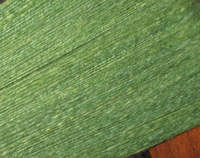
The yarn's close-up photo (right) gives you a better idea of its structure than does its portrait on the niddy-noddy. (Click on the thumbnail for a larger-than-life view.) The thicker, puffier zones are created by the neps in the hankies. Because this yarn is very, very fine, these don't feel "fuzzy", and because the non-neppy fibres are so long, the puffy spots are just as strong as the rest of the yarn. In the final weaving, they'll add liveliness and interest without actually showing.
And to end the happy morning report, a whiff of heartbreak -- for balance. Before spinning these silk hankies, I divided the hankie supply into two stacks that looked the same size, then spun each stack onto its own bobbin. Hankies are pretty consistent most of the time, and in the zillion times I've done this before, the two bobbins usually end up containing close to the same amount of yarn.
This time, though, quite a bit was left on one bobbin when the other ran out. It was late, I was eager to finish, and in the wee hours I made a disastrous choice: I decided to wind the remaining yarn onto my hand and ply from both ends that "mini-skein" (one end of which was still attached to the plying-in-progress).
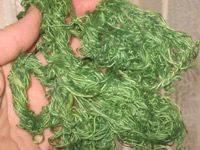
Usually this works okay -- especially with hankie-silk, which is forgiving stuff and behaves itself even with live twist. Alas, my attention wavered just as the cat jumped into my lap -- and one of the yarn ends disappeared from sight. The big snarl (left) is what resulted from my search for the missing end.
In the scheme of things, it's not a big deal -- the snarl probably contains just under 100 yards of singles. That's less than 10% of the total silk yarn from this batch. ...It's sad, all the same.
And yet.... Silk is such magical stuff, if you look closely at that snarl (click on the thumbnail), it's absolutely gorgeous! The undulations and corkscrews all catch the light, and the places where my probings separated the fibres sparkle with a life of their own.
A lovely green skein, and a disturbingly pretty silk snarl -- not bad for a night's work! :-)
There isn't a handy saying about Big Boxes, but Big Boxes sometimes contain small ones. (They sometimes also contain several kilos of silk fibre, ready to dye!)
And there is a famous saying about Small Boxes containing nice things. :-)
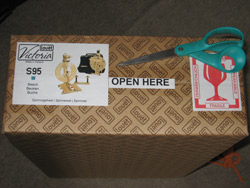
Even before I broke the seal, I was pretty sure that this small box (right) contained a Very Nice Thing, indeed.
Louet introduced the Victoria wheel in 2006, and as soon as I heard of it, I wanted to try it out. I wasn't actually in the same room with one for another two years or so -- but we finally met.
My first impression: I didn't fall in love, but it was a perfectly competent wheel. There was nothing wrong with the wheel -- it just didn't smite me with passion. It was easy to treadle, easy to adjust, very cleverly made, cute as a button -- but I didn't feel an aching need. ...And because of that, my head stayed cool enough to reflect that I couldn't afford its price tag anyway.
Then last year happened. I was home for less than two months in 2009. As usual, I'd travelled with spindles and lots of fibre -- but my sister's dominatrix cat was staying with me and thought the spindles were made expressly to bat and bite and claw. :-/ I needed to spin, and it wasn't possible. It was a sorry state of affairs.
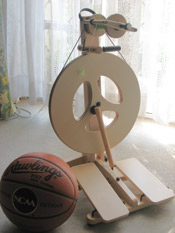
That experience led directly to the arrival of this Victoria. (That, plus I found it for an amazing price -- down in the zone that I not only could afford, but couldn't refuse!)
Look at it, standing there quietly by the window. Its footprint isn't much bigger than that of a basketball. It's a fully functional, carefully made, remarkably efficient, real spinning wheel. It folds and unfolds so easily that I think I'll keep it in its bag when it's not in use. And (I didn't expect this) -- it's pretty!
The proof of a wheel is in the spinning. So -- as it happened, I had a large baggie of dyed tussah, just sitting there; and of course, those lovely green silk hankies, waiting to be spun into a fine singles....
The wheel was very easy to set up for its first spin. The Victoria bobbins are slotted to make it easy to attach (and remove) a leader thread. Just poke the knotted end of the leader into the slot, give it a tug, and it's attached! Threading is a snap, too. The whole thing is designed so it's easy to thread with your fingers.
Right out of the box, the wheel has three drive whorls. I tried them all -- slow, medium, fast. Lovely, lovely, lovely. ...In fact, it's hard to really review this wheel, because there wasn't much of a learning curve in getting used to it. It just simply works.
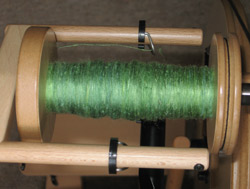
My first bobbinful was tussah silk (sorry, I was too excited to take a photo!). I experimented: thick(ish) yarn, fine yarn, slub yarn, fluffy yarn, high-sheen smooth yarn -- all were easy to spin without fiddling with the wheel.
Then I broke out the hankies, figuring I might as well try the wheel with a major spinning session. I spun all evening, making about 400 yards of medium-high-twist green singles. The results (right) speak volumes about this wheel. The yarn is fine, with those nice little textural neps you get from hankies -- but no "bloopy" areas where I'd had to tinker with wheel adjustments. With most of my wheels, a sustained spinning session like that would be broken frequently by an irresistable urge to Go Do Something Else -- but that didn't happen this time. The Victoria is responsive enough to do what I want, and fast enough to keep me interested in what I'm doing.
In short: it's a good wheel!
The wheel is so easy to set up and fun to use, it may very well see more spinning time than the other wheels around here. I'm happy. It will get lots of use. I appreciate it, admire it, enjoy it. But passion -- hmm.
As Joan Armatrading says: I am not in love, but I'm open to persuasion. :-)
A friend of mine is an incredibly good tablet weaver. She loves reproducing ancient tablet-woven bands and textiles, working from illustrations, photographs and inspection of the artifacts themselves. Yesterday when she called to ask what kind of green silk I had on hand, I suspected there was a historical project in it....
"Green?" I said. "What kind of green do you need?" She answered, "Oh, a nice green. A gentle green. Green like you see in Les Très Riches Heures du Duc de Berry. Look at May."
Interestingly enough, I knew what she meant. ;-)
If you see the fine lady upon the white horse (left), you'll see the shade of green in question. Her dress displays one intensity; the green-and-gold bands decorating her horse display another. This image is a detail of the month of May from the book, Les Très Riches Heures du Duc de Berry. The bands on the horse are the project my friend has in mind.
After more conversation, it was clear that silk hankies would be the best kind of silk for her project. She wanted sheen, and because it was for tablet weaving (and thus subject to twist in either direction), she wanted it to be very strong. And oh, yes, the final plied yarn should be about the same weight as buttonhole thread (definitely a job for silk hankies!).
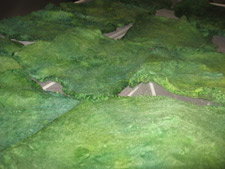
I checked my dye records, chose a likely-looking formula from Dyepots Past, and plunged 50g of hankies into the dyepot. I was nervous. The bombyx silk in the hankies was likely to take a deeper colour than the tussah I'd dyed with that formula before, and the simmering dyebath looked alarmingly dark....
After washing, though, the hankies look like they're all just right! In this photo, they're still damp. After drying, they were slightly lighter; but once they're spun, the colour will look deeper -- and it will deepen a little more when it's woven.
That was a lot of fun! :-) Besides being a nice (and successful!) dye day, it gave me a great excuse to re-explore the images in Les Très Riches Heures du Duc de Berry.
Here's a little background, for those unfamiliar with that book. In the Middle Ages, books were rare, handmade, and highly prized. One special form of medieval book appearing throughout Europe was known as the Book of Hours. These were devotional books which presented Biblical texts, prayers for certain times of the day, calendars, information, and meditations for daily living -- and they were often beautifully illustrated. There is no real modern equivalent to a Book of Hours -- but if there were, its content would be a blend of the Book of Common Prayer and the Farmer's Almanac: a mix of the spiritual and the pragmatic. And it would be staggeringly expensive, because each book would be hand-scribed, on pages made from real vellum, illustrated with pigments made from powdered precious stones. ;-)
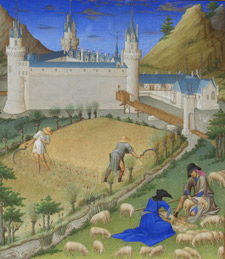
Les Très Riches Heures du Duc de Berry is a well-known Book of Hours set apart from the others by its lavish illuminations and rich hues. It was commissioned in the early 1400s by one of the most powerful dukes in western Europe, the Duke of Berry -- and it is one of the most beautiful of the surviving Books of Hours.
The Biblical and spiritual illuminations are splendidly coloured, and the calendar depicts not only the months (along with their astrological data), but also the activities that go with the seasons -- as in this detail of month of July (left), with its sheep shearing and wheat harvest. The castles in the background of most images represented real properties held by the Duke throughout France.
Wikipedia offers excellent background information on Books of Hours in general, and their article on Les Très Riches Heures du Duc de Berry contains clickable images of the major illustrations. Here's a link to that article (it will open in a new window): Les Très Riches Heures du Duc de Berry.
And why should we care? ...Because these images are beautiful, with the kind of beauty that feeds the soul. They are also full of information about traditions, textiles, daily life, and the way our world once was.
This was a fun dye project. And now I get to spin! :-)
Spring has burst forth and progressed rapidly, tax deadlines have arrived and passed less rapidly -- and it's obviously time to continue this update of the past weeks' activities. (I promise henceforth to refrain from any mention of accounting or taxes.)
So for something completely different -- today's recap starts with a visit "aux Puces"!
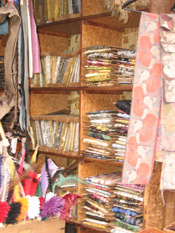
Before all else, here's a bit of background -- worth it, because the Parisian flea market has a long and colourful history. The story started centuries ago, when rag-pickers, scrap dealers, scam artists, and more-than-occasional thieves scoured the city for objects they could resell -- or pass off onto the unsuspecting.
This is not the kind of commerce city architects usually hope for; and toward the end of the 19th Century, along with a plethora of other civic projects, the governing bodies of Paris decided to "clean things up" inside the city.
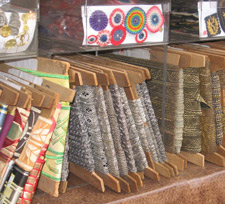 The rag-pickers, scrap dealers, et al were thus rounded up and moved to the other side of the city gates.
The rag-pickers, scrap dealers, et al were thus rounded up and moved to the other side of the city gates.
There, outside the city walls, they thrived. From the disorganized jumble, a real market emerged, formalized itself, set down roots, and grew. By the early 20th Century, it was well-established; and its stalls and avenues had already earned a reputation among Parisians as the Place to Go for anyone seeking an unusual object, a fine piece of old cloth, a rare curio, beautiful antique furnishings....
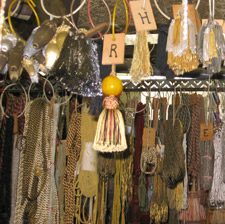
They tell a story here about the origin of the term "flea market". It's said that around the turn of the century, a well-known Parisian was standing on an upper floor, looking down at the activity of this many-faceted marketplace. As he watched the movement of the mixed (and largely non-aristocratic) crowd, he commented that they looked like a bunch of fleas. A journalist found his statement amusing, repeated it -- and the name stuck.
The modern-day Marché aux Puces is a small city unto itself, with avenues, restaurants, neighbourhoods, and real buildings. Within its buildings, stalls, and market tables, you can find the Exquisite displayed on the same shelf as the Mundane. Ancient textiles are sold alongside newly-released polyesters. You can purchase a piece of 17th-century tapestry just big enough to cover a cushion -- or buy new oilcloth by the meter for your picnic table.
The mixture is part of the charm.
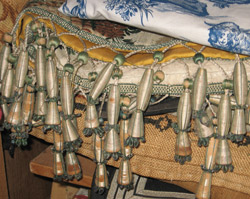
My friend and I were looking for old passementerie and tassels. She is familiar with the marketplace and all its various byways (she tantalized me terribly with stories of old spinning wheels being sold for a song!) -- but for me, it was my first visit. I was a babe in the wilderness, taking it all in with wide eyes. :-)
New things and old things make for a rich mix. The "gland" tassels (right) were old enough to have their under-structures showing through what once had been a bright silk covering. This was a beautifully made edging: a two-colour woven band with loops of cord along one side, and those loops adorned with multi-beaded, fringe-less tassels. (Click on the photo for a closer view.) The "beads" of the tassels are covered with a fine layer of silk floss. Their ends are garnished with a small flower-shaped frill, made from a silk-wrapped tape. --Originally quite elegant, this piece was relegated to the bottom shelf, mixed in with runners and tablecloths.
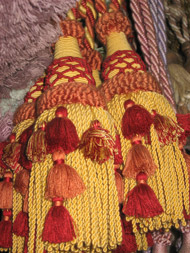
These large modern tassels (left) are what most people would hope to find on a tassel quest. These are simple in structure (i.e., there's a single mould forming the tassel head, and all else is embellishment), but beautifully effective. The small, soft-headed tassels adorning the skirt echo the looped garnish on the head; and the two ruffs pull all the colours together into a harmonious whole.
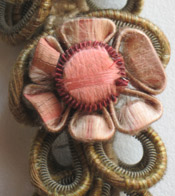
It was an amazing day. Just in terms of tassels, we saw new ones, old ones, simple ones, ecclesiastical tassels all in gold, fine silk tassels with intricate embellishments, heavy jute tassels to anchor weighty draperies. We saw, we touched, we purchased, and we admired.
Remembering the day brings back a heady sense of surprise and inspiration. I saw (but could not afford) a beautiful Coptic weaving (charming little ducks, all in a row). I held a 16th-century tapestry in my hands and examined its back, the natural-dyed colours still intense and vibrant where they'd been protected from the light.
On our way back to the car, at the edge of what was once the city wall, we passed through streets lined with tarp-covered stalls and filled with milling pedestrians. The air swirled with the smells of exotic foods and sounds: music, drumming, the mixed voices of sellers, buyers, barkers, friends.
It could have been Marrakech. It could have been Bombay. It could have been Maxwell Street. It could have been... Paris.
Winter was exceptionally long this year. We had late snows, unusually cold weeks, and strong, bitter winds. The days were short and dim, and the nights, dark, cold, and long. It seemed that it would never end!
Now, at last, a few timid buds show on the trees (no colour, just buds); and though I don't much feel like going out in the cold wind to meet them, my well-heated workroom has been full of comings and goings.
Admittedly, if you're looking through this little online window, it's probably seemed less than busy. That's a late-winter phenomenon, alas. I've been (pretty much) keeping up with e-mails, but other aspects of my "computer time" have lagged behind. ...We'll change that, starting now.
First and foremost: Colour (always a great way to start an update, don't you think?).
The buds outside may be shy and reluctant, but the indoor dyepots have been delivering, and in abundance! The material, as usual, is tussah silk -- and the colours are satisfyingly rich.
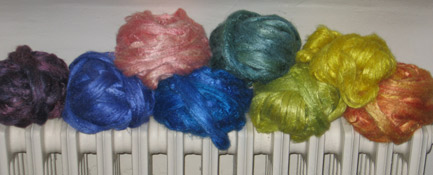
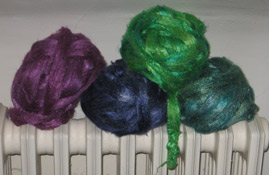
The photos above show a few days' worth of dyeing, in their last stages of drying. Once these large balls of sliver are fully dry, they'll be weighed and divided into "lumps" -- ready to package for anyone who yearns for some luxuriantly-coloured silk!
At the end of this round of dyeing, I'm pleased to report that my dyepot's full palette of colour is now on-hand and available -- and a couple of new colours (below) are almost ready for their online debut.
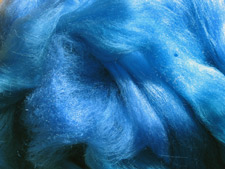
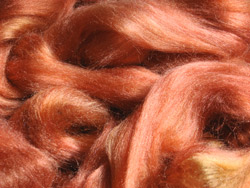
Stay tuned. There will be more.
This wintery scene appeared a few days ago, when light broke through the clouds at the end of the afternoon. Winter light is quite beautiful, its pearls and beiges speaking of cool seasons and long nights -- and calm. On rare days it's dazzling, with crystalline edges sharpening each bare branch; but even when it's not, the light draws our eyes upward and we catch our breath at the beauty.
Today is not a bright day. It's not even particularly light. The clouds are thick and heavy with rain, and a cold wind slaps against the windows. No wonder that as dawn broke, I dug out the dyepots for a blaze of colour!
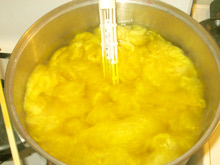
The first batch (silk, of course!) was a strong yellow -- sunny in its own right, to be sure; but this yellow was created as the base for other heart-warming hues: luminous Chartreuse and glowing Marigold. That large batch of Yellow emerged several hours ago. A pot full of Marigold simmers on the stove as I type this.
As it simmers, I think wintery thoughts.
Friendship is especially important in winter -- or maybe just especially appreciated. The pleasure of hearing a warm voice on the phone; a surprise letter in the mail; an e-mail from a long-silent friend; the gift that's rediscovered when you tidy your workspace -- these things feed the soul.
Late last November I got a surprise package from a spinning friend. It had been a rough year. My friend understood (as friends do!) and instinctively knew what would soothe and comfort me: the box contained a generous bag of cultivated silk (delicious pinks and oranges) and a beautiful, beautiful spindle.
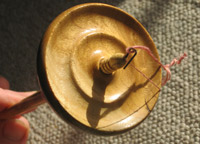
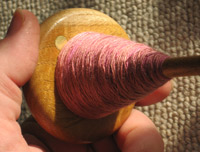
The spindle's whorl is mulberry wood -- what could possibly be more perfect for spinning cultivated silk?? (Click here if that doesn't make sense to you.)
It's lovely, satin-smooth, and flawlessly balanced. Flawlessly. Spinning, it's joy in motion.
Lots goes into balancing a spindle, and this one has something I hadn't seen before. If you look at the top of the whorl (Left - click on the image for a bigger view), you can see the wood is darker and denser on one side. Left to its own devices, that could create a wobble in the finished spindle. If I were making the spindle, I'd compensate by slightly shifting the hook -- but I'm a simple woodworker. The master craftsman who made this spindle addressed the problem much more elegantly (right). ...That bright spot is an embedded weight, placed on the side opposite the dense patch of wood. I don't know how he does it, but it's absolutely perfect. :-)
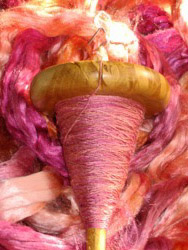
So. It's a dark, wet, wintery day. The dyepot simmers with sunny colours -- and I'm spinning with a perfect silk spindle. Pinks and oranges unfold one after the other, as the smooth cultivated silk fibres offer themselves effortlessly to the twist. The spindle whirls and descends, and with each turn it whispers, "Friendship".
It's really pretty easy to make a difference in people's lives. You share warmth, return it to someone who's running short, answer your phone and discover that someone's thinking of you. Friendship freely given -- there's nothing complicated about that.
But oh, what a difference it makes! :-)
When I find myself again having rich, rewarding days, I'll remember this -- and will send unexpected warmth to someone I know who needs the nudge of a friend.
End notes, for inquiring minds
♦ The absolutely beautiful perfect spindle came from the Spindlewood Company in Monmouth, Oregon (click here for their website). His woodworking is beautiful, and I suspect all of his spindles touch perfection.
♦ The baggie of beautiful silk came from Susan's Spinning Bunny (click here for their website) -- and its lovely oranges and pinks are in colourway called "Hot Stuff".
This package arrived here for me while I was in the States in December. It travelled all the way from rural China and waited patiently for my return -- then waited even more patiently for me to finish unpacking so I could open the box.
People who've received parcels from me often comment on the amount of tape used (I like to protect my shipments!) -- but this package easily outdoes any effort of mine. The yellow you see on the package is neither paper nor cardboard. It's tape. All of it.
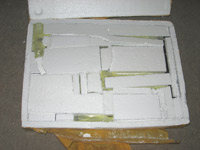
Hidden by the outer skin of tape was a styrofoam container. After delicately cutting along an almost-invisible seam, the back lifted off to reveal a magical puzzle of styrofoam blocks (right), meticulously shaped and trimmed to fill all the spaces around the main object.
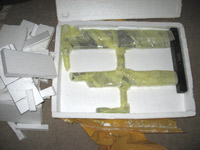
Removing the styrofoam puzzle pieces revealed the object itself, wrapped in its own protective cocoon (left). Even knowing what it was, I found the slow unveiling process enchanting. Who could guess what would come to light when the final layer was unwound? Whatever could it be??
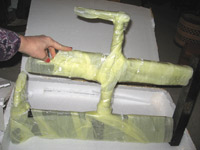
Tantalizing though this unveiling process is (and much as I like to draw things out), let me put you out of your anticipatory misery by telling all. ;-)
The story began in 2008 when I saw an old spinning wheel listed on eBay. It was a traditional charkha from rural China, and it was complete (except for the spindle and drive band). I loved it, thought about it, watched it in "My eBay"... and then it disappeared from view. I hadn't actually intended to buy it, but felt a real disappointment when it vanished from sight.
I thought about that charkha for a long time. I kept thinking about it. I thought about it so much that I decided to make the purchase the next time I got the chance -- if I got another chance.
Late last November, it happened: another charkha on eBay. I bought it.
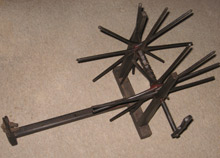
For those who are unfamiliar with charkhas, let me explain what you see in this photo. The picture was taken from a standing position, looking down at the wheel as it sits on the floor. On the left side of the photo is an upright piece with some twined cord threaded through it. This upright will support a spindle, holding it horizontally (like on a great wheel).
On the right side, that unpromising array of spiky things are the spokes of the drive wheel (click on the small photo to see it in more detail). There are two sets of them: front and back. To create the drive wheel, you lace back and forth between the spokes -- front to back, back to front, front to back.... The lacings cross over each other in the space between the front and back, creating a "rim" for the wheel -- a rim made of criss-crossed cord.
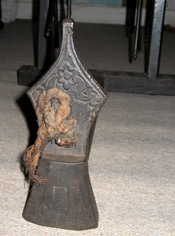
The drive band rides on this "rim", going around the drive wheel, then around the shaft of the spindle. You run the wheel by turning the drive wheel (it has a crank, which you can see in the photo above), and that, in turn, drives the spindle.
In this close-up of the spindle support (right), you can see the remnants of the cord used to hold the spindle in place. The original cord was twined from some unknown fibrous plant material, quite coarse. (The nice carving on the end is totally charming, isn't it?)
Very little needs to be done to this charkha to get it in working order. It needs a new spindle (I haven't decided yet if I should use steel or wood), and three types of cord: for the spindle support, for the "rim", and for the drive band.
Sounds to me like a nice project for the dark days of winter. :-)
The jet lag is brutal this month, but the weaving likes it. You can get quite a lot done before dawn, as it turns out.
This is the scarf-in-progress mentioned in my last post: a handspun merino-and-silk weft in deep shades woven through a handspun alpaca warp in black. I have to say that the reality of this cloth surpasses all my hopes. The fuzz of the merino gives it a soft surface, and the single ply of silk gleams through very subtly. In the midst of it all, the alpaca carries a sort of bass note -- with a gentle sheen.
The merino-and-silk yarn came about a little by chance. It's a three-ply yarn: two plies of merino and one of silk. All the fibres were space-dyed, so each ply of the yarn runs through its own undulations of colour independently. They work their way through blues and purples in the weaving, bringing one colour into focus, then another, and it's nice to see -- an unpredictable pleasure in deep tones.
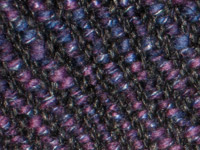
This detail photo (right) gives you a super close-up view of the interaction of the yarns, so you can see just how the elements of the three-ply yarn come into play. Click on the small image for a better view (it's worth it!).
The scarf was intended to be done by New Year's... but we'll settle for having it done in the New Year. ;-) Because I was travelling in December, the warp is set up on a series of three semi-rigid heddles (wider-than-usual prototypes). The set-up is portable and lightweight, exactly as I'd wanted, but feels a bit "approximate" with such a long warp. This warp is nearly 3 yards long, and it's stretched full-length across the room for weaving -- stabilized with extra pairs of lease sticks at regular intervals. It's a little like weaving on a tight rope. I'm not sure that's really how I want to do things....
It's an opportunity to discover the "better way". It will come. After all, where there's sleeplessness, there's time. :-)
The most important of all is this: things will be happening in my workroom again -- because (hurrah!) I get to stay home for a while! Stay tuned.
Return to the Archive directory page
Return to the Now spinning page
